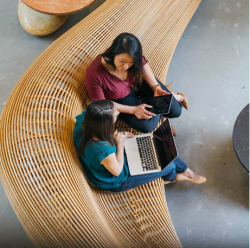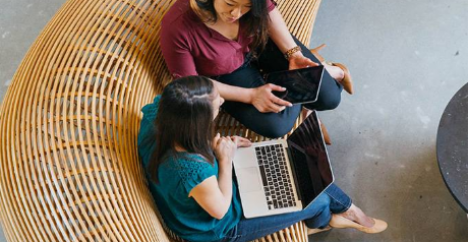July 5, 2023
All we are saying is give lease a chance
 By their very nature, trends come and go. What we are now seeing with sustainable, responsible product and material sourcing goes way beyond trend or fad, of course, and in recent discussions we’ve had (and we’ve had quite a few) on the subject, the question of furniture as a service or a furniture lease model has arisen on a number of occasions. So often, in fact, that we decided we should look deeper into the subject, to ascertain its pros (and cons) and to decipher whether this is merely a hypothetical – certainly at any large scale – that the industry would like to adopt or is a very real here and now.
By their very nature, trends come and go. What we are now seeing with sustainable, responsible product and material sourcing goes way beyond trend or fad, of course, and in recent discussions we’ve had (and we’ve had quite a few) on the subject, the question of furniture as a service or a furniture lease model has arisen on a number of occasions. So often, in fact, that we decided we should look deeper into the subject, to ascertain its pros (and cons) and to decipher whether this is merely a hypothetical – certainly at any large scale – that the industry would like to adopt or is a very real here and now.
After all, this isn’t something brand new in terms of concept. A quick Google search will reveal that there are a number of specialist businesses out there that can provide such a service, but it’s far more difficult to find any mention of the names and brands we know and love.
We started by sitting and chatting with Nicki Matthews, Director at Plus Finance, who is not new to the concept of furniture leasing.
“Money is still the driving force in the vast majority of cases,” she tells us. “Some businesses passionately care about responsible sourcing and a sustainable approach, but they are still relatively rare. There are more than there were 10 years ago, undoubtedly.
[perfectpullquote align=”right” bordertop=”false” cite=”” link=”” color=”” class=”” size=””]we’re now moving into a world being led by a new generation of young leaders whose outlook is quite different from those ‘box tickers’ of the past[/perfectpullquote]
“I’ve had a number of conversations (on the subject of furniture leasing) with leading furniture dealers – but not with the manufacturers, interestingly. The trouble is that there is an awful lot of talk about sustainability and a lot of clients feel like they need to tick that box, but the honest truth is that I’m not entirely sure that some of them care that much! It really is just ticking that box. Now, spreading the cost and renting furniture does do that because, fundamentally, if you buy furniture and, after five years, you don’t need it or you don’t want it anymore, it’s the client’s responsibility to ‘get rid of it’. That’s difficult. I was talking to someone recently who was saying that the biggest problem is not landfill – it’s burning. Burning is now a bigger issue than landfill.
“Technically, when it comes to leasing, at the end of the term the client has the opportunity to give the furniture back. From the client’s perspective, that box is now ticked because they have now given the furniture back and the onus is no longer on them. Actually, it now becomes my responsibility because I’ve taken it back.
“We need to be able to partner with dealers or with manufacturers, who will take that furniture back and then pass it on to charity – and there is quite a big call for that. Going back some 15 years, I had a programme with Interface, the carpet company, called Evergreen. What they were trying to do was to say to clients that they could have the flooring – and they were way ahead of the rest when it came to sustainability – and they would then take it away at then end of its life and they would refurbish the tiles to go out to schools or charities. It was way ahead of its time really – but people didn’t care enough at the time. It was absolutely brilliant but it never got the traction it deserved! We had even built into the monthly cost the cost of picking the product up and refurbishing it. And that made very little difference to the client’s overall monthly cost – so everyone was happy; the client was happy, we were happy and it was good for the environment because nothing was being wasted or sent to landfill. Furniture is, of course, slightly more difficult because it is much bigger and someone has to collect it and move it around.”
Nicki agrees that we’re now moving into a world being led by a new generation of young leaders whose outlook is quite different from those ‘box tickers’ of the past. “I don’t know what the complete answer is,” she admits. “I think that, if you’re going to look at this like you would a contract hire car, where you give it back at the end and it is no longer your responsibility, then it works in terms of financing it. People know from the very start that they will have the furniture for five years and then it will be returned – but the manufacturer or supplier has to get involved in that process. From their perspective, this does mean that there is every chance of another ‘sale’ after five years.
“It is definitely being talked about – we’re having plenty of conversations on the subject right now, but the truth is that, when it comes to it, clients do not see this as hugely important to them right now. They want to consider the option, to discuss the possibility, but it’s more about the suppliers wanting to offer it because they care about the environmental aspect – or, in some cases, be wanting to be seen as caring about the environmental aspect.
“In saying that, having talked about this a lot with various people and having done quite a lot of work on it, not a lot has actually happened. I haven’t seen or heard anything out there. It’s quite a difficult thing because the suppliers who really do want to get involved Understand that it will have an impact on their business. They realise that it will cost and they will have to commit to doing something with that furniture. It comes back to the same question of responsibility.”
Definitely maybe
With Nicki’s words still very much in our minds, we headed out to the inaugural Sustainable Design Collective’s inaugural forum and awards at Clerkenwell’s Crypt on the Green, where we took the opportunity to ask a selection of the Collective’s members to give us their thought on the subject, starting with one of the country’s leading suppliers, The Furniture Practice.
“We have got involved in lease purchase, and I believe that all options are on the table,” Matt Davies, Director of Sustainability, considers. “I think that, in the future, there will be some exciting options for it beyond just the obvious – especially in terms of second hand furniture. Watch this space! I also think that, on a fit-out, there ought to be options when it comes to the ‘hard book’ items – the desk, storage, task chair etc. You then align these with quality products.
“To be honest, this isn’t something that our clients are coming to us and asking about, but we are having chats around the side of things. I’m not sure that, at the moment, the financial models are there – I’m not sure that the market is quite ready to facilitate such a model right now. In time, maybe. It’s not beyond the wit of man to see the opportunity to move to a rental of subscription model in the future. There are many advantages – not least the fact that we would be able to look after our clients in a responsible manner.”
MCM Architecture’s Design Director, Deepak Parmar, also sees opportunities for change in the way people acquire furniture in the not too distant future. “I’m really interested in this. It has to go down this route. Almost everything else now goes down this route, so why not furniture?”
Deepak tells us that he recently came across a Scandinavian business with a particularly impressive furniture leasing model. “They’re called Nornorm have a really impressive offer,” he confirms. “They buy furniture from good, well-known brands such as Hay, Herman Miller and Knoll – and we’re talking about functional furniture such as desks, meeting tables, task chairs, etc – and their clients pay not much more than the equivalent of a cup of coffee per day. For that, every three months you can switch things in and out and change your furniture settings as you want and need them to be. They will come in, swap furniture in and out, take things away and repair things and make sure that everything looks good, and this is just a simple leasing model. But it does need to be on a certain scale. This is why they are not doing the ‘soft’ stuff. They do all the functional stuff and then allow the designer to put their mark on a project by doing the soft furniture – the ‘clubhouse’ stuff. This also allows them to be really focused on what they do.”
There is no doubt that the furniture leasing model is a hot topic and is gaining traction. There is a new generation of leaders who care about more than ‘just’ the bottom line, and that means they are not afraid of taking responsibility (on all levels). As Matt suggested, this will take time. We’re still largely talking about hypotheticals. So, not quite yet. But soon. Definitely. Maybe.

Mick Jordan is the editor of Works Magazine
This feature appears in issue 15 of IN Magazine













